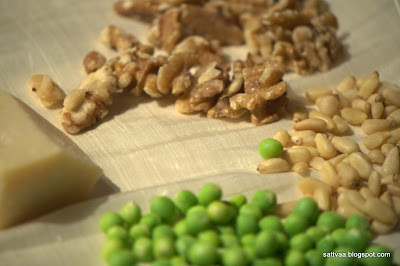Spring, Easter, bunny rabbits, egg hunt and carrot cakes - there is so much love, freshness and warmth in these that it definitely makes you look out and enjoy the new life all around you. Spring is called 'Vasantha' in Kannada, isn't that a beautiful name? It is the season when life starts anew. Nature that went into hibernation in the cold winter, wakes up, shrugs off all the dust and just like that you see them blooming and creating a wonderland all around you. As the temperature took a dive South last week, I thought Spring was still a distant dream. But the white fluffy snow melted away almost as quickly as it came down and it was back to sun shine and warmth again. It is a beautiful 65F in my part of the world today. Come to think of it, I like all seasons, right now I am basking in the warm Spring weather.
What is your favorite Spring time activity? I love to walk outdoors. As I dropped off DD for her music lessons, I planned my hour and had my target set for a brisk walk trying to spot my favorite blooms along the way. As I walked some distance, I saw an elderly gentleman walking a little distance ahead of me. I tried to walk behind him but since it slowed me down considerably, I excused myself and passed him. A short distance later I had to stop at a traffic signal and he came there too. As we waited for the lights to change, I said Hello and got ready to resume my walk again. As I took a step forward, he suddenly said, "Did you know Nargis?" :-), what a conversation starter, I thought. Although I was thinking I had to go back to my speed walking, I slowed down to walk with him and I am glad I did.
He turned out to be a photographer who had taken Raj Kapoor and Nargis's pictures when they visited his home country Iran. I told him although I had not watched either of them, I had heard a lot about the two great actors from my mother. As we walked on and chatted, he told me a story about an Indian Prince and princess and how the prince fights with snakes to prove his worth to marry her :-). He mentioned that it has been his dream to visit India and visit some of the temples for architecture and history, I hope he gets a chance to do it. After about a half mile or so, he stopped and said, "Nice talking to you, I will be stopping here" and went into the Senior living center. I would have missed meeting a charming gentleman if I had just hurried on, I certainly hope I meet him again another day. As I went on my walk further, I wished with all my heart he had enjoyed talking to me as much as I did to him. For some strange reason, I remembered my mother living far away. I am sure she makes a great conversation and has a lot to share with others too.
I came across this great twist to a classic carrot cake which is almost a symbol of Spring celebrations. The recipe is from a magazine and uses a fruit juice to enhance the flavor of carrots in this recipe. Carrot cake being a favorite of DD, I thought I will try this recipe and it turned out fabulous. I didn't use eggs though and instead went for an egg replacement. The frosting is very simple too with just cream cheese, butter (yeah, some more) and sugar with some vanilla flavoring. This is a layered cake with frosting. Beautiful colors and great tasting cake, it felt like biting into the floating, white, fluffy clouds.
Be forewarned that this cake is rich, it has oodles of butter. Share it with friends. It is alright to eat rich food once in a while, just go for a long walk in the balmy weather to burn off the calories and say Hello to strangers you meet on the way.
What do you need to make Carrot cake?
Recipe Source: Better Homes magazine
2 cups All purpose flour
1 cup sugar
1 Tblsp baking powder
1/4 Tsp fresh ground nutmeg
1/2 cup (1 US stick) butter - softened
2 Tblsp flax seeds powder (original recipe calls for 2 eggs)
11/4 cup mango juice
1/2 Tsp salt
3 packed cups shredded carrot
1/2 cup chopped walnuts (optional but recommended)
Cream cheese frosting:
8 Oz cream cheese - at room temperature( I got reduced fat)
1/2 stick (1/4 cup) butter
2.5-3 cups powdered sugar (depends on the thickness and sweetness you like for the frosting, I used only 2.5 cups)
1 Tsp vanilla essence
How do you make Carrot cake?
What is your favorite Spring time activity? I love to walk outdoors. As I dropped off DD for her music lessons, I planned my hour and had my target set for a brisk walk trying to spot my favorite blooms along the way. As I walked some distance, I saw an elderly gentleman walking a little distance ahead of me. I tried to walk behind him but since it slowed me down considerably, I excused myself and passed him. A short distance later I had to stop at a traffic signal and he came there too. As we waited for the lights to change, I said Hello and got ready to resume my walk again. As I took a step forward, he suddenly said, "Did you know Nargis?" :-), what a conversation starter, I thought. Although I was thinking I had to go back to my speed walking, I slowed down to walk with him and I am glad I did.
He turned out to be a photographer who had taken Raj Kapoor and Nargis's pictures when they visited his home country Iran. I told him although I had not watched either of them, I had heard a lot about the two great actors from my mother. As we walked on and chatted, he told me a story about an Indian Prince and princess and how the prince fights with snakes to prove his worth to marry her :-). He mentioned that it has been his dream to visit India and visit some of the temples for architecture and history, I hope he gets a chance to do it. After about a half mile or so, he stopped and said, "Nice talking to you, I will be stopping here" and went into the Senior living center. I would have missed meeting a charming gentleman if I had just hurried on, I certainly hope I meet him again another day. As I went on my walk further, I wished with all my heart he had enjoyed talking to me as much as I did to him. For some strange reason, I remembered my mother living far away. I am sure she makes a great conversation and has a lot to share with others too.
I came across this great twist to a classic carrot cake which is almost a symbol of Spring celebrations. The recipe is from a magazine and uses a fruit juice to enhance the flavor of carrots in this recipe. Carrot cake being a favorite of DD, I thought I will try this recipe and it turned out fabulous. I didn't use eggs though and instead went for an egg replacement. The frosting is very simple too with just cream cheese, butter (yeah, some more) and sugar with some vanilla flavoring. This is a layered cake with frosting. Beautiful colors and great tasting cake, it felt like biting into the floating, white, fluffy clouds.
Be forewarned that this cake is rich, it has oodles of butter. Share it with friends. It is alright to eat rich food once in a while, just go for a long walk in the balmy weather to burn off the calories and say Hello to strangers you meet on the way.
 |
| Cherry blossoms along the way as we walked |
Recipe Source: Better Homes magazine
2 cups All purpose flour
1 cup sugar
1 Tblsp baking powder
1/4 Tsp fresh ground nutmeg
1/2 cup (1 US stick) butter - softened
2 Tblsp flax seeds powder (original recipe calls for 2 eggs)
11/4 cup mango juice
1/2 Tsp salt
3 packed cups shredded carrot
1/2 cup chopped walnuts (optional but recommended)
Cream cheese frosting:
8 Oz cream cheese - at room temperature( I got reduced fat)
1/2 stick (1/4 cup) butter
2.5-3 cups powdered sugar (depends on the thickness and sweetness you like for the frosting, I used only 2.5 cups)
1 Tsp vanilla essence
How do you make Carrot cake?
- Add 6 Tblsp of water to the flax seeds powder, mix it once and keep aside until ready to use (atleast 10 minutes)
- Preheat oven to 350F, grease and flour two 8.5 inch round cake pans and set aside.
- Combine flour, baking powder, salt and nutmeg powder. Mix it with a spoon.
- In a large bowl, beat the softened butter (keep the butter outside until it is soft to touch) until creamy. A hand mixer or a whisk will do this job very well.
- Add the sugar and continue to whisk until sugar dissolves and incorporates with butter.
- Add the gooey flax powder mixture and beat once.
- Slowly add the dry flour mixture, mixing continuously with a spoon.
- Add 3/4 cup of the mango juice, chopped walnuts and shredded carrot. Mix it well to incorporate.
- Pour evenly into the prepared pans and bake it for 25-30 minutes or until a tooth pick comes out clean.
- Take the cake pans out and keep it outside for 6-8 minutes to cool.
- Remove the cakes from the pans and lay them on a wire rack until it cools completely.
- Boil the remaining 1/2 cup mango juice in a sauce pan until it thickens and reduces by half. Let it cool.
- Lay one of the cakes in a wide plate, apply a layer of frosting evenly.
- Lay the second cake on top and frost the surface (thickness depends on your taste).
- Drizzle the thickened mango juice on top for flavoring.
- Cut slices and enjoy.
Cream cheese frosting:
- Beat the softened butter and cream cheese until light and creamy.
- Mix in the vanilla essence.
- Slowly add the powdered sugar until you get the desired consistency.
Notes:
- Flax seeds powder works as a great egg replacement. One egg = 1 Tblsp flax seeds powder mixed in 3 Tblsp water
- You can pour all the batter into a single pan, bake it and eat it without any frosting. It tastes just great.
- The cream cheese frosting is very neutral in taste and hence allows the taste of the carrots to come out stronger. You can frost it any other way you like.
- I really think the mango juice and the drizzled mango concentrate made this cake super delicious, but you can skip this and make the traditional carrot cake.
Updated on Dec 29, 2013:
- I used pomegranate juice instead of the mango juice to add to the batter and skipped the flavoring on top of cake. This juice gave a slightly darker color to the cake and tasted great. So go ahead and experiment with different juices preferably those with milder flavors.
- I used unsweetened apple sauce as the egg replacement this time. 1 egg = 1/4 cup of apple sauce.
- I made the cake in a bundt pan and covered it with icing on top.

















































